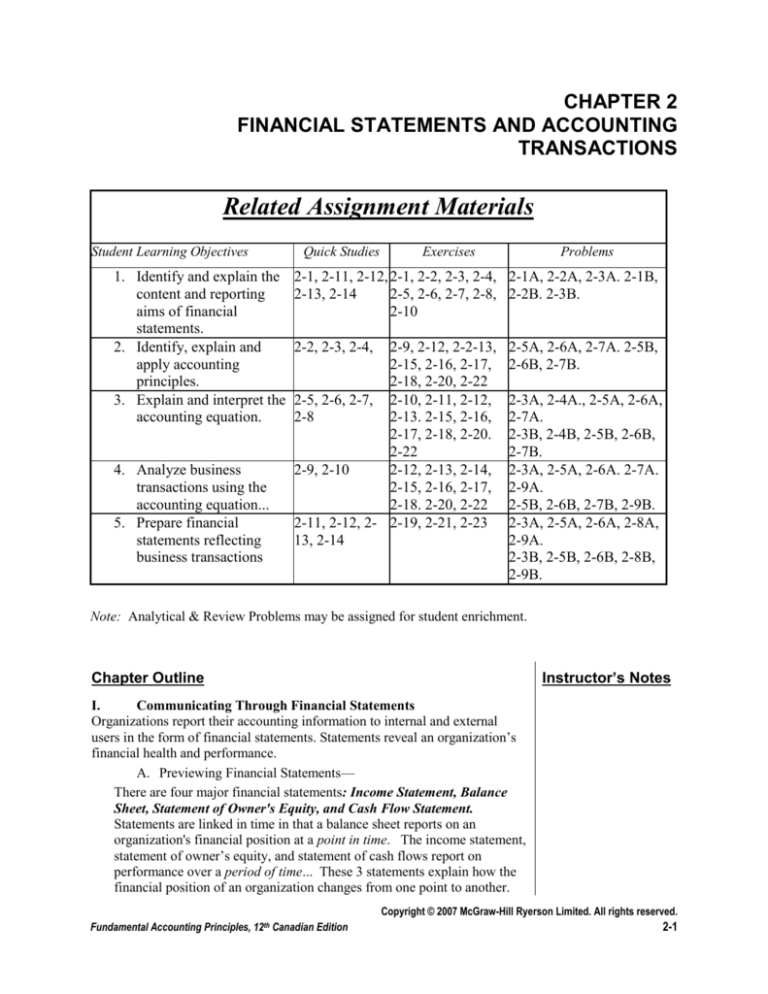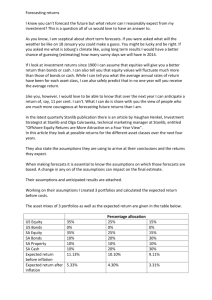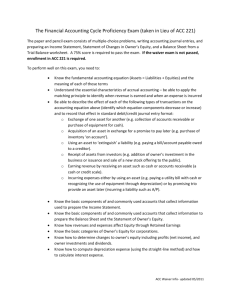
CHAPTER 2
FINANCIAL STATEMENTS AND ACCOUNTING
TRANSACTIONS
Related Assignment Materials
Student Learning Objectives
1. Identify and explain the
content and reporting
aims of financial
statements.
2. Identify, explain and
apply accounting
principles.
3. Explain and interpret the
accounting equation.
4. Analyze business
transactions using the
accounting equation...
5. Prepare financial
statements reflecting
business transactions
Quick Studies
Exercises
Problems
2-1, 2-11, 2-12, 2-1, 2-2, 2-3, 2-4, 2-1A, 2-2A, 2-3A. 2-1B,
2-13, 2-14
2-5, 2-6, 2-7, 2-8, 2-2B. 2-3B.
2-10
2-2, 2-3, 2-4,
2-9, 2-12, 2-2-13,
2-15, 2-16, 2-17,
2-18, 2-20, 2-22
2-5, 2-6, 2-7, 2-10, 2-11, 2-12,
2-8
2-13. 2-15, 2-16,
2-17, 2-18, 2-20.
2-22
2-9, 2-10
2-12, 2-13, 2-14,
2-15, 2-16, 2-17,
2-18. 2-20, 2-22
2-11, 2-12, 2- 2-19, 2-21, 2-23
13, 2-14
2-5A, 2-6A, 2-7A. 2-5B,
2-6B, 2-7B.
2-3A, 2-4A., 2-5A, 2-6A,
2-7A.
2-3B, 2-4B, 2-5B, 2-6B,
2-7B.
2-3A, 2-5A, 2-6A. 2-7A.
2-9A.
2-5B, 2-6B, 2-7B, 2-9B.
2-3A, 2-5A, 2-6A, 2-8A,
2-9A.
2-3B, 2-5B, 2-6B, 2-8B,
2-9B.
Note: Analytical & Review Problems may be assigned for student enrichment.
Instructor’s Notes
Chapter Outline
I.
Communicating Through Financial Statements
Organizations report their accounting information to internal and external
users in the form of financial statements. Statements reveal an organization’s
financial health and performance.
A. Previewing Financial Statements—
There are four major financial statements: Income Statement, Balance
Sheet, Statement of Owner's Equity, and Cash Flow Statement.
Statements are linked in time in that a balance sheet reports on an
organization's financial position at a point in time. The income statement,
statement of owner’s equity, and statement of cash flows report on
performance over a period of time... These 3 statements explain how the
financial position of an organization changes from one point to another.
Copyright © 2007 McGraw-Hill Ryerson Limited. All rights reserved.
Fundamental Accounting Principles, 12th Canadian Edition
2-1
Instructor’s Notes
Chapter Outline
1. The income statement reports revenues earned and
expenses incurred by a business during a given period Net
income results when revenues are greater than expenses. Net
loss occurs when expenses are greater than revenues for a
period.
Revenues—value of assets exchanged for products or services
provided to customers.
Expenses—costs incurred or the using up of assets from
generating revenue..
II.
2. The statement owner's equity shows the beginning and
ending balances of owner's equity for a period, and the items
that caused the net change, including: Owner’s equity
represents how much of the assets belong to the owner.
Increases due to investments by the owner and/or net income.
Decreases due to withdrawals by the owner and/or a net loss.
3. The balance sheet reports the financial position of the
business at a point in time, usually at the end of a month or a
year.
Assets—properties or economic resources owned by the
business. Common characteristic is the ability to provide
probable future economic benefits to the business.
Liabilities—debts or obligations of a business or claims
against assets. A common characteristic is capacity to reduce
future assets or to require future services or products.
Equity—is the owner’s claim to the assets or the residual
interest in the assets of an entity after deducting liabilities;
also called net assets.
4. The Cash Flow Statement - describes the sources and uses
of cash for a reporting period. The cash flows are classified as
being caused by operating, investing, and financing activities.
The statement also reports the beginning, ending and change
in cash.
B. Financial Statements and Forms of Organizations
The focus of the early chapters of this book is on proprietorships.
Exhibit 2-7 gives a brief outline of differences business organization.
Generally Accepted Accounting Principles (GAAP)
A. The rules that make acceptable accounting practices are referred to
as Generally Accepted Accounting Principles (GAAP). Information
presented using these principles are considered to be relevant, reliable,
consistent and comparable.
Fundamental Principles of Accounting
Include both general and specific principles and are discussed
throughout the book. The principles discussed in this chapter are:
1. Business entity principle—every business is to be accounted
Copyright © 2007 McGraw-Hill Ryerson Limited. All rights reserved.
2-2
Fundamental Accounting Principles, 12th Canadian Edition
Instructor’s Notes
Chapter Outline
III.
IV.
for separately and distinctly from its owner or owners.
2. Cost principle—all transactions are recorded based on actual
cash amount received. A cash-equivalent amount may be
given in exchange.
3. Objectivity principle—financial statement information is to be
supported by independent, unbiased and verifiable evidence.
4. Going-concern principle—financial statements are to reflect
the assumption that the business will continue operating
instead of being closed or sold, unless evidence shows that it
will not continue.
5. Monetary Unit—transactions and events must be expressed in
monetary, or money, units which is generally the currency in
which it operates. Accounting assumes a stable monetary unit,
which means we do not account for change in the value of
currency.
6. Revenue recognition principle—revenue should be recognized
at the time it is earned. The inflow of assets associated with
revenue may be in a form other than cash. The amount of
revenue should be measured as the cash plus the cash
equivalent (market value) of any other assets received.
The Accounting Equation
Investing=Financing, Equal amounts of investment and financing
have to occur in order for the accounting equation to remain balanced.
Transactions and the Accounting Equation
Business activities are described as transactions or events. Some
economic consideration (something of value) is exchanged for
something else in a transaction. These transactions cause changes
to the accounting equation. Source documents identify and
describe the transactions. The source documents provide the data
to be entered into the accounting system. Business events do not
involve exchange of economic consideration. Assets will always
equal liabilities plus owner’s equity.
A. Transaction Analysis
1. Investment by owner
+Asset (Cash) = + Owner’s Equity (Owner’s Name,
Capital)
reason: investment
Increase on both sides of equation keeps equation in
balance.
2. Purchase supplies for cash
+Asset (Supplies) = -Asset (Cash)
Increase and decrease on one side of the equation keeps
the equation in balance.
3. Purchase furniture and supplies on credit =
+Asset (Supplies)+Asset(Furniture) = + Liability
(Accounts Payable)
Copyright © 2007 McGraw-Hill Ryerson Limited. All rights reserved.
Fundamental Accounting Principles, 12th Canadian Edition
2-3
Instructor’s Notes
Chapter Outline
V.
Increase on both sides of equation keeps equation in
balance.
4. Services rendered for cash =
+ Asset (Cash) = + Owner’s Equity(Owner’s Name,
Capital)
reason: revenue earned
Increase on both sides of equation keeps equation in
balance.
5. Payment of expenses in cash
- Asset (Cash) = - Owner’s Equity(Owner’s Name,
Capital)
( rent) reason: expense incurred
Decrease on both sides of equation keeps equation in
balance.
6. Payment of expenses in cash
- Asset (Cash) = - Owner’s Equity (Owner’s Name,
Capital)
(Salary) reason: expense incurred
Decrease on both sides of equation keeps equation in
balance.
Revenue Recognition Principle--requires revenues be
recorded to be reported in the period it is earned.
7. Service contract signed, no effect on accounting equation
as no transactions has yet occurred.
8. Services and rental revenues rendered services for credit =
+ Asset (Accts Rec.) = + O E (Owner’s Name, Capital)
Reason revenue earned
Increase on both sides of equation keeps equation in balance.
9. Receipt of cash on account =
+ Asset (Cash) = - Asset (Accounts Receivable)
Increase and decrease on one side of the equation keeps the
equation in balance.
10. Payment of an accounts payable =
- Asset (Cash) = - Liability (Accounts Payable)
Decrease on both sides of equation keeps equation in
balance.
11. Withdrawal of cash by Owner =
- Asset (Cash) = - O E (Owner’s Name, Capital)
reason: withdrawal
Decrease on both sides of equation keeps equation in
balance.
Summary of transactions is shown in Exhibit 2-10.
Financial Statements
Financial Statements are prepared from transaction analysis in the
following order using the procedure indicated:
Copyright © 2007 McGraw-Hill Ryerson Limited. All rights reserved.
2-4
Fundamental Accounting Principles, 12th Canadian Edition
Instructor’s Notes
Chapter Outline
A. Income Statement – information about revenues and expenses is
taken from the owner's equity column. Total revenues minus total
expenses equals net income or loss. Notice withdrawals and
investments are not part of measuring income or loss.(This is a very
common mistake for students at this point.)
B. Statement of Owner’s Equity -- the beginning owner’ equity is
taken from the owner’s equity column and any investments of owner
showed in this column are added. The net income, from the income
statement is added ( or the net loss is subtracted) and finally the
owner’s withdrawals, which are found in the owner’s equity column,
are subtracted to arrive at the ending capital. (Point out that balance is
already known from the transaction sheet.)
C. Balance Sheet -- the ending balance of each asset is listed and the
total of this listing equals total assets. The ending balance of each
liability is listed and the total of this listing equals total liabilities. The
ending capital, taken from the statement of changes in owner’s equity,
is listed and added to total liabilities to get total liabilities and owner’s
equity. Both sides must equal.
Copyright © 2007 McGraw-Hill Ryerson Limited. All rights reserved.
Fundamental Accounting Principles, 12th Canadian Edition
2-5










